Journal

The WIP Balancing Act - The Big Secret to Managing Multiple WIPs!
Following on from last week's article, I received a lovely email from a customer who wanted to know how to manage multiple WIPs. She said she would love to have a few projects on the go, but finds herself getting lost or losing interest in projects when working in multiples. So, this week I thought it might be useful to share how I manage multiple WIPs, and my secret to keeping everything manageable and under control.
Right off the bat, I'll tell you my secret... it's organisation. You really need to be organised or, at least, have some sort of system when working on a lot of WIPs. This prevents you from losing track of where you are in a pattern, forgetting what projects you've cast on, and keeps you focused and motivated. So here are my tips; I hope you find them useful!
- Make Sure You Have Enough Yarn - Pretty self explanatory, but very important. Nothing stalls a WIP faster than running out of yarn. So, when you order/buy yarn or if you are stash diving, make sure you have enough yardage to finish your project.
- Create a Dedicated Project Bag For Each WIP - I find this very helpful and much better than putting everything in a basket all together. In my project bag, I put a copy of the pattern (I like to print it - but I'll talk about this later), the needles/cables I'll need for the project, and any other bits and bobs required (i.e. stitch markers, extra cables, waste yarn etc.). Then, when I want to work on my project, I know I can grab my bag and everything I need will be contained within it. I don't have to search for patterns or needles; everything is nicely organised and ready to go.
- Write Notes On Your Patterns - I usually print patterns and store them in my bags along with my projects. As I go, I write notes on the pattern to indicate any modifications I might have done, the size I am knitting, the needle sizes I am using and where I am in the pattern (I tick off each section as I go or, if I'm working on a chart, I make a note on what row I'm up to before I put my project away). I think this is one of the most helpful things to do when working in multiples. Coming back to a project and trying to work out where you are in the pattern/what size you are knitting etc. can deter a lot of people from working on the project or even finishing it. So, make sure you keep notes! Of course you can do this on your phone, on digital patterns, in a note book or on a scrap piece of paper that you put in your project bag. Just make sure you take notes in some form and keep them up to date - it's so incredibly helpful.
- Use a Project Tracker To Account For/Keep Track Of Your WIPs - For this, I use Ravelry, but you can also use another system that suits you better. As soon as I cast on, I create a project page and enter all the major details (i.e. yarn/yardage, size, needle size etc.). I can then revisit my project page and easily see the number of WIPs that I currently have on the go. This helps me to keep track of things: I can see if my WIPs are piling up and, if so, it gets me motivated to finish a few (so I can cast on more!).
- Having A Good Variety Of Complexity - I spoke about this last week, but make sure your WIPs vary in complexity. Having a variety of easy, moderate and difficult projects means you'll have a good selection of projects to work on, depending on mood/energy levels and time constraints. Feeling tired? Knit socks. Feeling like a challenge? Work on the cabled sweater. So, when you're planning your next project, think about what you're already working on and decide if it will fit in well with what you've already got. This also might help motivate you to finish a WIP in order to make room for the next cast on!
- Try To Work A Bit On Each Project As Often As You Can But Don't Make Knitting Feel Like A Chore - Keep all your projects together in a place you like to knit and, depending on mood, grab a project that will feel good to work on. If one project has got you excited and you want to keep working on it, do it! You might power through and finish it. Whatever you do, don't make knitting a chore. It's OK to let projects marinate for a little while. But, if you can, try to work on each project at least once a week.
- If You're Not Feeling It, Frog It - Knitting is meant to be an enjoyable and relaxing hobby; it shouldn't be a weight around our necks. If there's a project that just doesn't feel fun to knit, or you've lost all interest in it, then frog it and free your needles and yarn for something that you'll love. Don't hesitate, just move on: knit happens!
I would love to hear how you manage your WIPs. Do you have a system in place or organise your WIPs in any particular way? Or, do you just cast on and knit! I would love to know; please comment below.
Also, is there anything you would like me to write about? It's always helpful to get suggestions. Feel free to message me!
Next week, I'll be sharing my tips on how to get all those languishing WIPs off the needles.
Happy Knitting,
Kristen xx

The More WIPs, The Merrier: The Many Benefits Of Having Multiple WIPs
When I first started knitting, I could only manage one project at a time. This makes sense because the learning curve is steep, and working on too many projects would have been overwhelming. But, as my experience grew, so did my pile of WIPs! I've come to realise that having multiple WIPs is actually quite beneficial, and I thought that this week I would share my musings with you.
- Projects For All Occasions
Having multiple WIPs gives us the freedom to choose a project that matches our current mood/energy level or time constraints. I know that at the end of the day, I'm more likely to reach for something simple (a sock project or working on sleeves), while knitting during a lunch break is great for more complicated things like colourwork, lace and cables. If you are a multi-WIP knitter, you probably have a project or two that you can grab as you walk out the door. Something portable and easy you can work on during appointments, school pick ups, meetings etc.... a project you can easily pick up and put down. No matter where we are or what we're doing, having multiple WIPs ensure we always have a suitable project to work on.
- Sampling An Array Of Complexity
This ties in well with the above idea. Let's say I was only allowed to work on one project at a time. I would probably choose something simple, mainly because, no matter the circumstance, I could work on it. Would this become boring? For me, yes it would. Having multiple WIPs means I have a nice variety of complexity. Some simple, some intermediate and some hard. So, no matter what mood/situation I find myself in, I always have a project I can work on. Sprinkling in some challenging projects also helps us to learn more/maintain our knitting skills too!
-
Process vs Product
Some knitters enjoy the process of knitting itself, finding satisfaction in the creation of the fabric rather than solely focusing on the finished object. Personally I am a product knitter, but I can see why a process knitter would find a lot of joy in having a variety of WIPs focusing on, let's say, different stitch patterns or interesting constructions.
- Increased Sense of Accomplishment
I don't know about you but I find when I'm working in multiples, I tend to finish a stack of things at the same time. It seems once I get one project off the needles, I'm spurred on to finish the next and then the next: it's like a domino effect. I find that sense of accomplishment is a big motivator for me to get those languishing WIPs done.
- Maintaining our Interest and Feeding Creativity
I know that there are times that I suddenly crave certain projects. I'll see a Colourwork sweater and instantly want to cast it on. Or a pattern has been released and I really want to knit it now! Or maybe even a certain colour or yarn catches my eye and I urgently want to work with it! Allowing ourselves to give in to these urges keeps our knitting mojo high, keeps us interested in our hobby, and is great for feeding/fuelling our creativity.
There are many more benefits to having multiple WIPs. I could have actually kept on writing but I want to keep this short(ish). On the flip side, though, there are a few downsides, too. I think the biggest one is when the WIP pile morphs into a hibernation pile and things just languish. So, I thought it would be fun to make August the month of finishing, which ultimately frees up needles and project bags for more things! I'm going to run a ....KAL/CAL over on Ravelry, Instagram and Discord so we can all work on finishing things and, at the same time, encourage each other with new patterns to cast on. I hope you can join me! Details below.
Ultimately, the number of WIPs a knitter has is a personal preference. I would love to know if you embrace the idea of lots of WIPs, or do you prefer just having one or two? Feel free to let me know by commenting below!
WIP It KAL/CAL
Let's crack those WIPs and get them under control this August!
- We are hosting our WIP IT KAL/CAL via Ravelry, Discord and Instagram (#wipitkalcal).
- All you have to do is grab a WIP (or two or three) and work on finishing it.
- All WIPs are welcome; they don't need to be knit in our yarn.
- The KAL/CAL runs from 1-31st August.
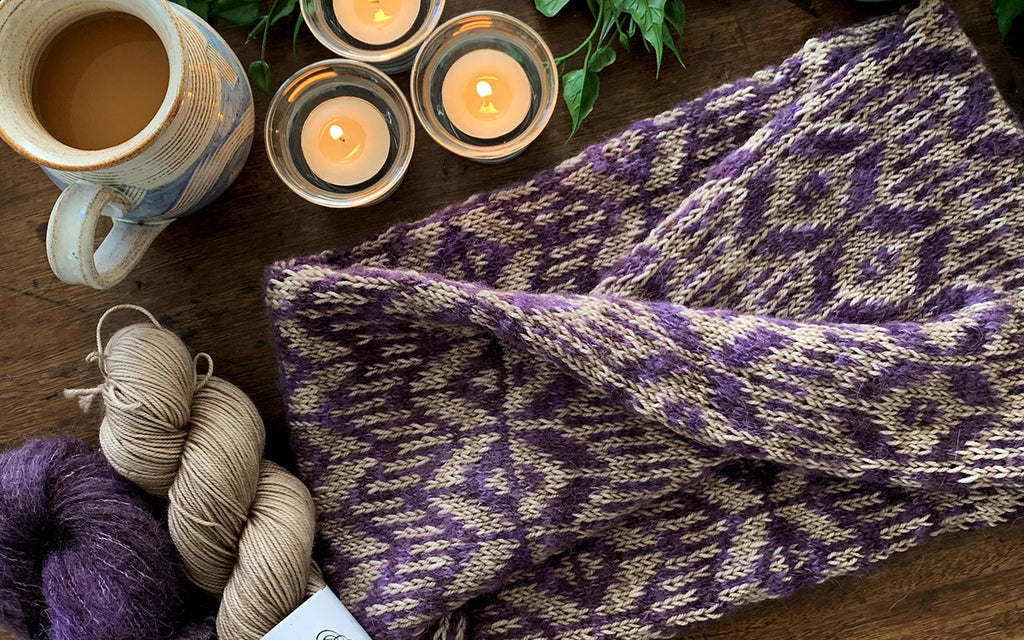
Solstice KAL
June is the month of our winter solstice here in Australia, which makes it the perfect time to have a winter accessories KAL.
** THE DETAILS **
* This is a winter accessories KAL: hats, cowls, gloves, socks, legwarmers, shawls etc. are all perfect.
* Cast on is June 1 and the KAL will run until June 30
* This is an open KAL, so you can use ANY yarn you have in your stash (it doesn't have to be our yarn)
* WIPs are fine to knit on, too!
* The KAL will be held on our Ravelry group, Discord and you can post on Instagram as well with #sysolsticeKAL
* There will be prizes! We will be randomly selecting posts with pictures on all three platforms - so, make sure you post! If you do use our yarn, you will get a double entry bonus for prizes.
Come join us for some pre-cast-on chatter and let us know what you are thinking of knitting!
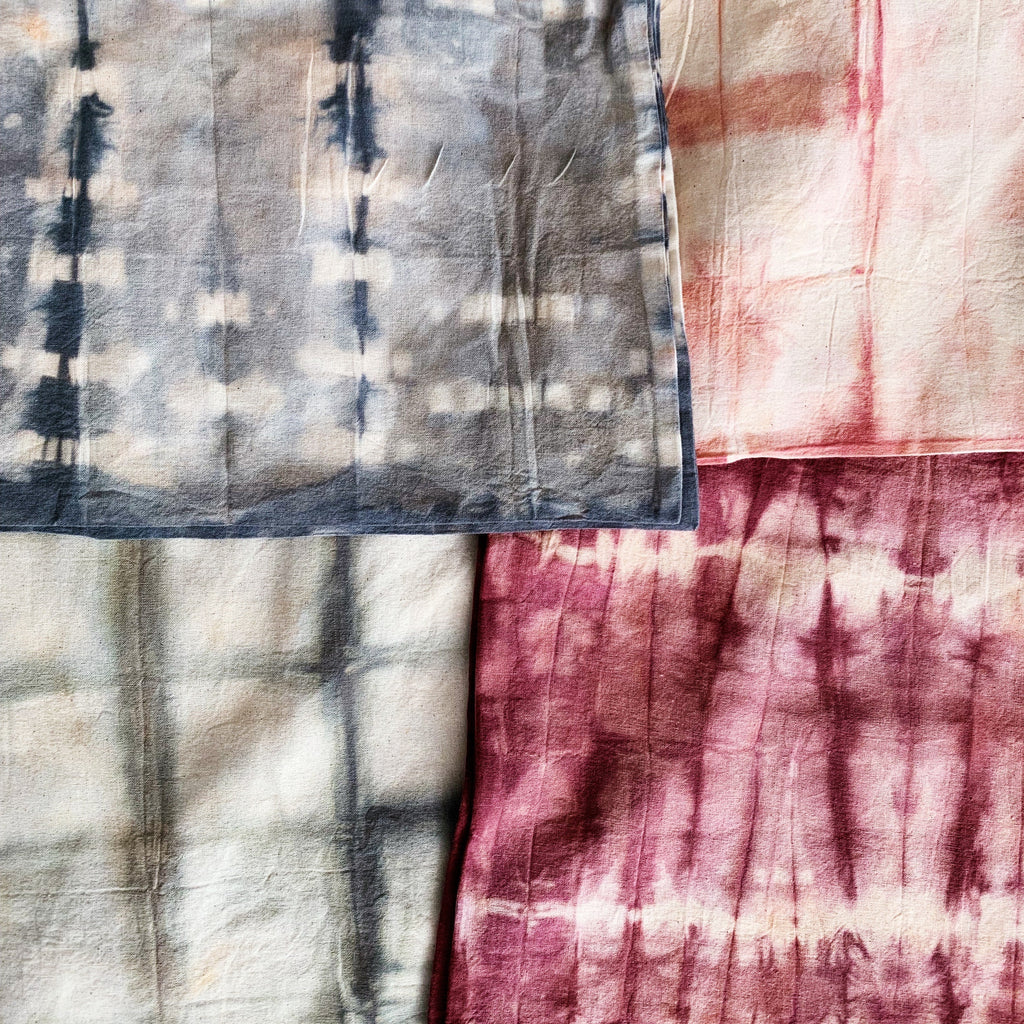
The Six Different Types Of Shibori
Shibori is the traditional Japanese method of resist dyeing that can be traced back to the 6th century. It literally translates as 'to wring, squeeze or press' and involves various techniques that can include binding, folding, stitching, pressing or crumpling the fabric prior to dyeing. Traditionally, there are six different types of shibori techniques that each have their own symbolic meanings related to nature and life. Today, we are delving into each of these methods: Kanoko, Kumo, Miura, Itajime, Arashi and Nui. I have added videos so that you can see a demonstration of each technique and, hopefully, be enticed to try them yourself!
Kanoko
Translates as 'fawn' and is most similar to the western method of tie-dye. Fabric is bound by string or rubber bands to create a pattern or spots similar to those seen on a fawn's back. The Kanoko pattern symbolises longevity and the richness of nature.

Photo credit: Shibori
Kumo
Literally means 'spider' and the resulting pattern using this technique resembles spider webs. The fabric is gathered and bound tightly and closely with thread. The fabric can also be pleated finely to enhance the design. Kumo symbolises wisdom and the intricate beauty of life.

Photo Credit: Art Threads
Miura
Uses a hooked needle to pluck sections of fabric that are then bound by a thread. The thread is left loose with no knots, making it very easy to unbind the fabric once dyed. The process, however, is very time consuming. Yet the resulting patterns are so beautiful and fittingly symbolise the ebb and flow of tides, linking it to the fluidity of life.
Photo Credit: Talu
Itajime
Literally meaning 'board-clamping' in Japanese, this technique uses wooden boards or templates, between which folded fabric is sandwiched and then clamped. The boards or shapes form the resist and prevent dye from touching the fabric. The fabric itself is folded in a precise way, thereby creating patterns that are geometrical in nature and symbolise stability and the earth.
Arashi
Literally meaning 'storm', it is a technique where the fabric is wrapped diagonally around a pole and then tightly bound with string. The fabric is then scrunched together and dyed. The resulting pattern symbolises driving rain and represents the dynamic and sometimes overwhelming forces of nature.

Photo Credit: Common Fold Blog
Nui
This method of shibori uses stitches to form a resist that results in a wide variety of patterns. There are many different ways to use this method, from complex designs to simpler running stitches.

Photo Credit: The Printed Fabric Bee
Interested in trying shibori or have you already given it a go? Let me know in the comments below.

Yarniversary and a MAL
We turn 15 in May!!!
It's amazing how quickly time flies! I started Skein back in May 2010 and I NEVER thought that fifteen years later I would still be dyeing yarn. I really am so grateful for all your support over the years.
I have lots of fun plans for May, but I wanted to do an early announcement for our May Make-A-Long, which coincides with our yarniversary (details below). Stash yarn is totally fine to use for the MAL; however, if you would like to cast on with something new, we're celebrating our 15 years with 15% off our in-stock yarns. Having the sale now means you'll get your yarns in time to cast on with us on May 1!
I've got lots of fun things planned, and I can't wait for May to arrive so I can share everything with you!
15% off in-stock yarn until Sunday night! Use the code YARNIVERSARY
Celebrate our 15 year yarniversary this May with a month-long Make-A-Long! Join us in creating something fun with our yarn while we talk about old times and future plans.
Here are the details:
* Our MAL starts on May 1
* Use all or part of Skein Yarn in a project.
* All crafts are welcome! Crochet, weave, knit, punch needle, embroider etc.
* The MAL will be held over on our Ravelry group.
* You can also share your projects on Instagram #symakealong
* There will be prizes! To enter, you must post in our Ravelry group or use the hashtag on Instagram. All posts from 1-31st May are eligible for prizes.
* There's no pressure to complete your project. We want this to be fun and relaxing.
* Last day of the MAL is May 31
I have already started a thread on Ravelry, so come on over and let me know what you are planning to knit, and what yarn base and colour/s you are using. Feel free to tag me on Instagram, too (@skeinyarn)!
Happy knitting!
Kristen xx

Mid Winter Knitwear Spruce Up
An Effortless Airing
A Simple Steam Clean
A Quick Spritz
Making your own fabric spray is a great way to add a lovely scent to your hand knits. Choose your favourite essential oil and make up a spray with witch hazel and water (see this post for the recipe) and spritz away whenever you like.
And there you have it!
Let me know if you have any tips for keeping your hand knits fresh throughout winter.

Assigned Pooling
I love dyeing up long-repeat colourways. I also love the way they look when skeined up. However, knitting with them can be challenging. The biggest issue is pooling, which looks fabulous for socks but can, for some people, be a problem in larger projects like shawls and sweaters. This is where assigned pooling comes to the rescue!
So, how does assigned pooling work? Basically, the shortest colour repeat is worked into a 'yarn hungry' textured-stitch pattern (i.e. bobbles/nups, wrapped stitches or even short rows) which gathers together this colour repeat in small clusters. Every time you come to the colour change, this stitch pattern is worked. The longest colour repeat forms the 'background' that is usually worked in stockinette stitch. It's a very creative and interesting way to deal with yarns that pool.

So, what colours work best for assigned-pooling projects? You want to look for yarns that have been dyed in two distinct sections: one will be long, and the second short. Here's an example of our colour Aster that we developed especially for assigned pooling; it was used for our sample shawl (pattern is Calico by Dawn Barker).


If you are searching for assigned pooling projects, you must check out Dawn Barker who is the creative innovator behind this fabulous technique. She has a ton of patterns developed especially for long-repeat colourways. Here's just a few!
Have you tried assigned pooling before? Is this something you are interested in trying? Let us know in the comments below!

Knitting With Bouclé
Bouclé yarns are making a bit of a comeback, but what can you knit with them? I get asked this question regularly. There's not a lot of patterns out there (yet!) and it isn't a yarn most knitters are familiar with. So, I thought now would be a great time to write a blog post to give you all some simple tips on what patterns to look for when using bouclé.
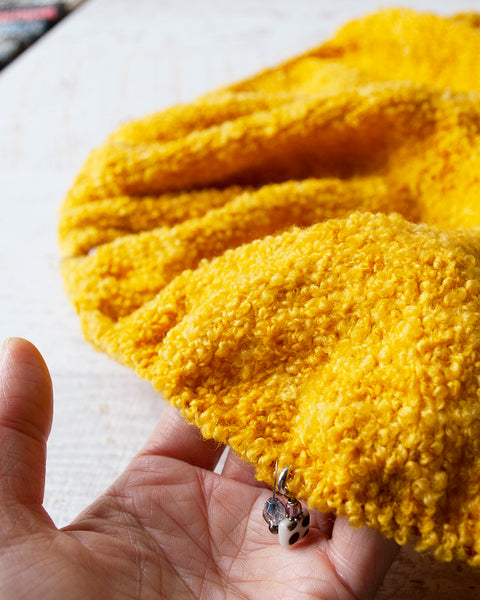
Firstly, bouclé yarn is highly textured. The yarn itself features lots of tiny loops that knit up into a fabric that looks a little like terry toweling. Because of this, you don't want to choose patterns that feature fancy stitches, cables or lace - these details will be hidden under all those loops. The best patterns for bouclé feature simple stockinette or garter stitch with, or without, a rib.
Colourwork, on the other hand, looks great. Stripes, slipped stitches, stranded colourwork, even brioche looks great knit in bouclé yarn. I'm planning to cast on a Soldotna Crop by Caitlin Hunter with our bouclé yarn Curly. I can't wait to see how it turns out!
Basically, the simpler the stitch the better when choosing patterns for bouclé yarn. The most important thing to look for is a pattern that features simple stockinette or garter stitch with or without colourwork.
Here's a few pattern ideas:

Superlative Sweater by Samantha Guerin

Ship Shape by Heidi Kirrmaier
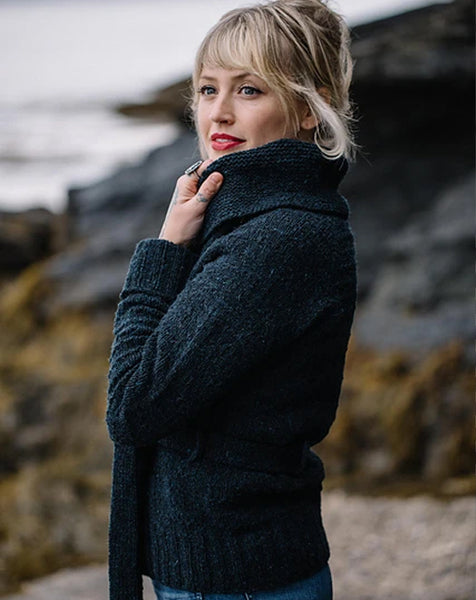
Ginny by Andrea Mowrey
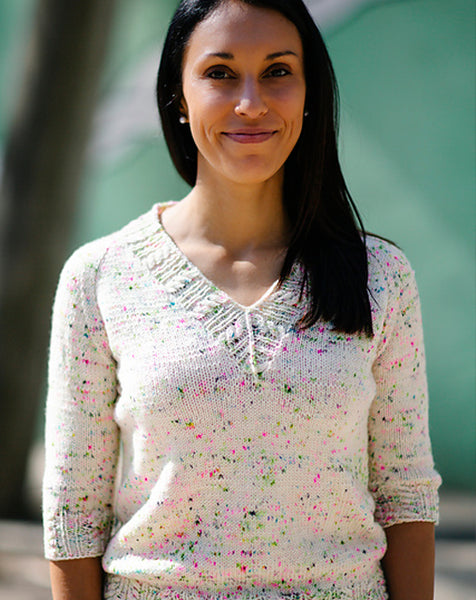
Arco Iris by Joji Locatelli
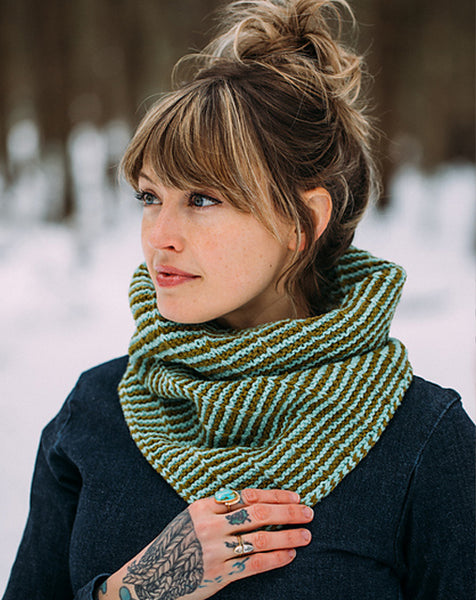
DRK Everyday Cowl by Andrea Mowrey

Field Day Cardigan by Hailey Smedley

Balloon Cardigan by PetiteKnit (this is the pattern I knit, pictured in the beginning of the article)
Hope this helps!

Five amazing properties of Llama Fibre
This week, we are introducing Bubs: our new yarn base spun from 100% baby llama. Baby llama refers to the first shearing, which is done when the animal is in its adolescence. The first shearing produces the finest quality fibre that is highly sought after in the textile market. To be honest, I didn't know much about Llama fibre, so I did some research and found out how amazing it is.
1. One of the warmest fibres on the planet
Llama fibre is hollow, so it provides greater surface area for insulation and thermal properties, making it even warmer than wool. Because the fibre is hollow, its weighs less, making it super lightweight yet incredibly toasty. Also, the hollow core wicks away moisture, keeping it away from the skin.
2. Does not contain oil
Unlike most animal fibres, llama contains no natural oils or lanolin. Most fibre allergies are caused by a reaction to the oil in the fibre. As llama is oil free, it is considered to be hypo-allergenic - great news for people with wool or other fibre allergies!
3. Llama fiber lacks 'crimp'
If you were to compare a strand of llama fibre to wool under a microscope, you will see that it looks very flat and smooth and does not have the crimp associated with wool. Just like silk, llama is smooth to the touch, strong, and has a beautiful drape.
4. Naturally microbial
Studies have shown that llama fibre is naturally resistant to bacteria. This means that items made from llama fibre do not need to be washed as often because the fibre is able to naturally rid itself of bacteria, which in turn keeps it smelling clean and fresh.
5. Flame resistant
Just like wool, llama is flame resistant. It does not support a flame or melt, making it a very safe fibre to wear or to have in the home.

Pattern Spotlight - Soldotna Crop With A Twist.
This week our pattern spotlight is the Soldotna Crop by Caitlin Hunter. I have been knitting one for myself using our Cushy DK/8ply and, since it's our yarn of the week, I thought it would be perfect for our spotlight pattern.

The Soldotna Crop was designed to use four colours; however, I have seen three colour versions and was inspired to try them myself. I'm using Olive, Parchment and Orchid and I am super happy with how it's knitting up! This does mean that the small colourwork 'spots' in the body will be omitted, but I'm totally fine with that.
If you are interested in creating your own three-colour Soldotna Crop, here are my tips.
I suggest choosing a palette that consists of a dark, a medium (or a bright) and a light colour. This will give you the best contrast and will really make the colourwork pop. Next, you need to work out your colour placement. The pattern is written for four colours (C1, C2, C3, C4), and this is my suggestion for how to order your colours for a three-colour version.
Light-Coloured Soldotna Crop (body will be light)
- C1 - will be your darkest colour
- C2 - will be your lightest colour
- C3 - will be your medium or bright colour
- C4 - you will use colour 2
Dark-Coloured Soldotna Crop (body will be dark)
- C1 - will be your lightest colour
- C2 - will be your darkest colour
- C3 - will be your medium or bright colour
- C4 - you will use colour 2
I am knitting a light version, so my C1 is Olive, C2 and C4 is Parchment, and C3 is Orchid.
If you are after some new stash to cast on a three-colour Soldotna, I have put together a few colour palettes using this week's colourways. They have been photographed in order with the first 2 skeins on the left being light, then dark and the medium/bright at the end. You can create your own light or dark Soldotna using any of these combinations (I have listed the yardage you will need below).







- Silver (light), Char (Dark) and Just Peachy (mid/bright).
- Botticelli (light), Midnight Blue (dark) and Just Peachy (mid/bright).
- Parchment (light), Olive (dark), Orchid (mid/bright).
- Tequila (light), Marigold (dark), Thistle (mid/bright).
- Silver (light), Char (dark), Orchid (mid/bright).
- Silver (light), Char (dark), Marigold (mid/bright).
- Tequila (light), Sushi (dark), Persimmon (mid/bright).
For a three-colour version your yardage will of course change; here is what you will need.
Sizes 1(2,3,4,5,6){7,8,9,10}
Finished circumference at bust:
32.75 (36.5, 40, 44.5, 48, 52.5) {56, 59.75, 64, 67.75} ”
83 (92.5, 101.5, 113, 122, 133.5) {142, 152, 162.5, 172} cm
This sweater is designed to fit with 1-4.5” 2.5-11.5 cm of positive ease at the bust.
C1: 1 (1, 2, 2, 2, 2) {2, 2, 2, 2} skeins Cushy/DK weight yarn.
C2: 2 (2, 2, 2, 2, 2) {2, 3, 3, 3} skeins Cushy/DK weight yarn.
C3: 1 (1, 1, 1, 1, 1) {1, 1, 1, 1} skeins Cushy/DK weight yarn.
If you have any questions, just use our contact page and I'll get back to you.
Have a great weekend xx

Elton Pullover by Joji Locatelli
We are super excited about Joji Locatelli's newest release, the Elton Pullover. This gorgeous design features alternating bands of Mohair Silk Lace and Fingering-weight yarns which not only creates an interesting texture, but also a light, yet warm, pullover that would be fabulous for Autumn.
Because we love this design so much, we have decided to put together kits featuring our favourite colour duets that we think will look stunning knit up as Elton Pullovers. We've chosen speckled/variegated colours for the fingering-weight yarn (Uptown Sock) and coordinating semi-solid colours for the Mohair Silk Lace. This combination of will create a fabulous effect that will be perfect for this design. Here are the kits!



SIZES
1 (2, 3, 4, 5, 6, 7, 8, 9, 10). Shown in size 3 on a 36” bust.
Recommended ease: Approx. 16” (40 cm) of positive ease.
FINISHED MEASUREMENTS
Bust circumference: 44 (48, 52, 56, 60, 64, 68, 72, 76, 80)“ 110 (120, 130, 140, 150, 160, 170, 180, 190, 200) cm.
Yardage
2 (2, 2, 3, 3, 3, 4, 4, 4, 4) skeins of Uptown Sock
1 (1, 1, 2, 2, 2, 2, 2, 2, 3) skeins Mohair Silk Lace
Kit Colours
Kit 1: Hydrangea and Botticelli
Kit 2: Boho and Cotton Seed
Kit 3: Summer Nights and Char
Kit 4: Cane Fields and Iroko
Kit 5: Aquatic and Big Teal
Kit 6: Black Cherries and Tamarind
Kit 7: Antique Brass and Tequila
Kit 8: Bloom and Golden Peach
The kits are now available; as they are pre orders, they will ship in around 2-3 weeks.
Happy Knitting! xx

Mount Pleasant by Megan Nodecker
This summery top has been on our radar for quite some time and, with the weather warming up, we thought now would be the perfect time to spotlight this gorgeous pattern.
This cute, cropped top, designed by Megan Nodecker, is knit from the top down in easy stockinette and features a very sweet, scalloped hem. The drop-shoulder design gives the top an elegant look, and the wider neck and cropped length is perfect for wearing in warmer days.
This week, our feature yarn is All Rounder (perfect for this top). We have dyed up some fun speckles; you can see all the colours here. We also dye this yarn to order if there is a special colourway you wish to order!



Sizes
XS (S, M, L, XL, 2X, 3X, 4X, 5X)
Bust circumference: 30 (34, 38, 42, 46, 50, 54, 58, 62)“ / 76 (86, 97, 107, 117, 127, 137, 147, 157) cm to be work with 0-2” / 5 cm or more positive ease.
Yardage
2 (2, 2, 2, 3, 3, 3, 3, 4) skeins of All Rounder
Mount Pleasant by Megan Nodecker is available via Ravely.
Happy Knitting! xx




